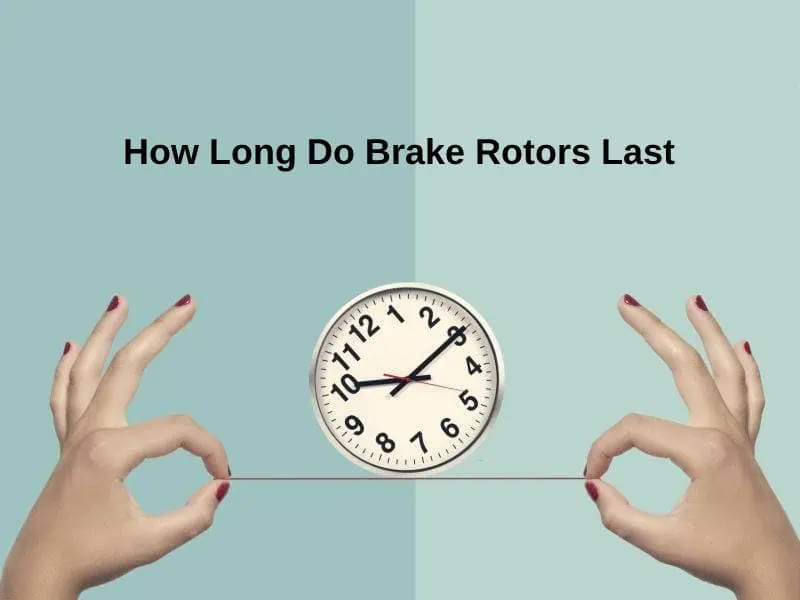Exact Answer: 35000-75000 Miles
Your safety is dependent on the braking system of your vehicle. To avoid an accident or mishap when driving, you must be able to stop or slow down at any time. In a panic and stop situation, if your brakes aren’t operating properly, they won’t work. The braking system of an automobile is made up of many different components that must all function together to provide a safe stop.
So, you cannot afford to make any compromises when it comes to brakes. Because they generate heat to stop your car, disc brake rotors, or discs, wear out. Excessive dust on the wheels and weird noises etc. could all be signs that you should replace them.

How Long Do Brake Rotors Last?
| Usage Limit | Duration |
| Minimum | 35000 Miles |
| Maximum | 75000 Miles |
Your brake system is one of the most important parts of your car, and it is designed to resist the most extreme conditions. Even short excursions to the supermarket necessitate 50 stops, so you can imagine the amount of wear they endure over time. Maintaining them in good working order should always be a top priority for your safety and the safety of those around you.
When most people think of brake servicing, they think of brake pads, and with good reason: they’re the first portion of the brake system to wear out. Most people are aware that the brake rotors are also included in this system, and while they aren’t the primary component that has to be replaced, they do need to be checked regularly.
It is always a great idea to inspect your brakes regularly. When we say this, we mean a visual inspection of the brake pad and brake shoe thickness as well. The wheel cylinders and other parts must be checked on time and should be in working condition. Not just this, the brake rotors should also be inspected to see if there are any hot areas. Other than that, brake fluid’s level, as well as the brake and antilock brake sensors, should all be examined.
Brake rotors need to be replaced over time since they are constantly in use when you are driving. The wear occurs as a result of continual friction and lasts between 35,000 and 75,000 kilometres. They also tend to deform when heated by friction and driven through water, necessitating the purchase of new rotors. You will notice wear and other concerns when it comes to brake rotors. This is mainly because brake rotors play an important part in the operation of cars.
Why Do Brake Rotors Last That Long?
The life of brake rotors is contingent on several things. Wear is caused by the weight of your vehicle, as well as any cargo or passengers. Heavy loads necessitate more brake pressure to come to a halt. When towing a trailer, the extra weight is a major consideration. It helps that modern trailers have separate brake systems that interact with some automobiles.
Brake rotor wear is also influenced by your driving behaviour. If you drive fast, your brakes have to work harder. Before activating the brakes, try coasting, also known as engine braking, and allowing your vehicle’s natural weight to assist in slowing you down. Learning to follow at a safe distance and predicting when you’ll need to stop, as well as driving slower, will aid with coasting.
It is important to consider the quality of the rotors. Buildings and materials of the higher grade will last longer than those of lower quality. Brake rotors of superior quality are also more effective. Using less expensive rotors may wind up costing you more money in the long run because they wear out faster. Although your rotors are one of the most durable elements of your vehicle, the variables listed above might limit their life.
Depending on the above criteria, your rotors should last between 30,000 and 70,000 kilometres. Only rotors with no cracks and rust etc. can be resurfaced. Never refinish a rotor above the minimum thickness specified by the manufacturer. Rotors that have been machined above their minimum thickness are unable to dissipate heat, resulting in longer stopping distances and the danger of disc failure.
Conclusion
Rotors absorb and distribute heat generated during braking, although heat is the primary cause of rotor wear and warping. When your brake rotors get overheated so that the metal hardens to a smooth shining sheen, the brake pads can no longer cause friction when clamped around the rotor, this is known as glazing.
Excessive rotor wear can be caused by mechanical issues such as binding brake callipers, a faulty wheel bearing, or semi-metallic brake pads that may have been fitted at some stage. Uneven or overtightening lug nuts with an impact wrench can also deform rotors, which is commonly overlooked. So, we hope now all your queries about brake rotors are clear and you know about the life of brake rotors.